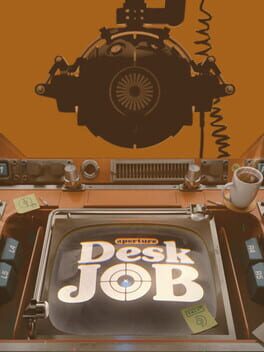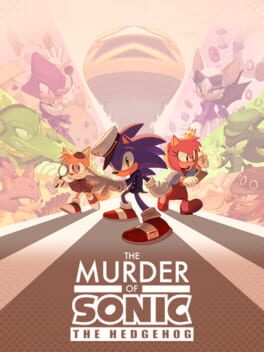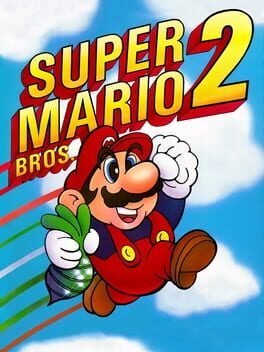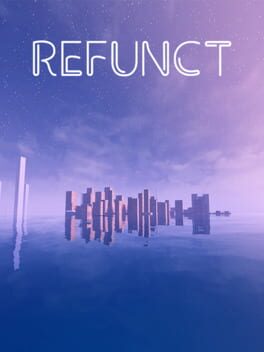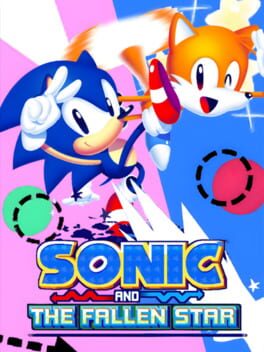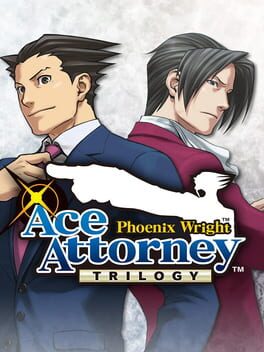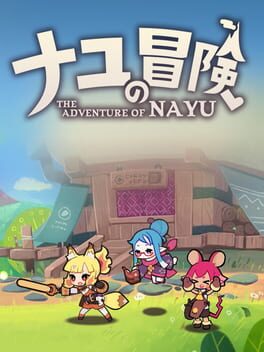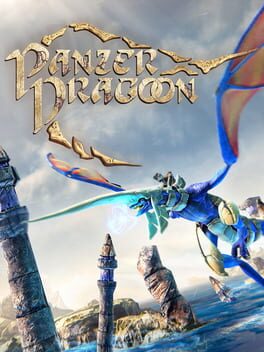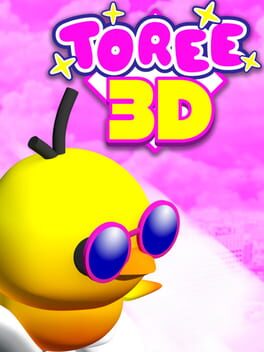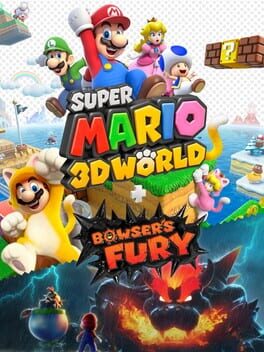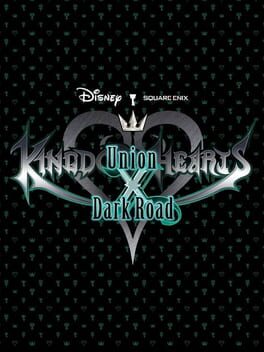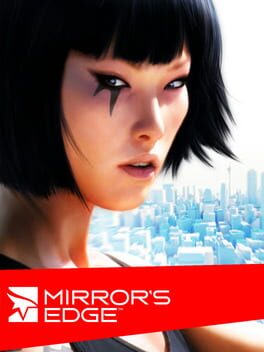Lozicle
2022
It didn't really make me laugh much, but it was cute enough. Wish it went more in-depth with the Steam Deck's features. Still, for a free, 30-minute game, it was fine.
The real April Fools Day joke is that this seems like an ironic joke game poking fun at how infamous the franchise has become when in reality it's a genuine labor of love with some of the best character-driven comedic writing in the series. This is a great tribute to the extended Sonic cast, and a fun detective game in its own right.
1988
To know that Super Mario Bros. 2 is an altered version of the Japanese game Yume Kōjō: Doki Doki Panic is knowledge. To understand that Super Mario Bros. 2 is the true successor to the original Super Mario Bros. is wisdom.
2021
Annalynn pays homage to classic '80s arcade games like Pac-Man, Donkey Kong, and Mario Bros. It takes dot collecting, multi-colored enemies, and temporary power-ups from Pac-Man. The differing levels and jumping action are from Donkey Kong. Enemy-kicking feels right out of Mario Bros. I can't say Annalynn is as elegant as those games, nor that it establishes an identity distinct from them, but it's about as addictive as them and substantially more approachable.
The aesthetics are on-point. The visuals call back to the art found in the arcades, albeit with some nice enhancements (characters have more frames of animation, for example). The music uses an arcade-like soundfont, but it's written like later NES games. And it slaps. Sound effects are also pleasant, and they punctuate the action well. The presentation makes the game feel like a throwback done right, but it has its own additions too.
The characters are appealing and presented with a ton of charm thanks to the way they're shown in cutscenes between levels. Like in Pac-Man, a short scene will play every few levels, one before each new area. Not only do these flesh out the context, they sometimes introduce new hazards that will appear in the next set of levels. Thus, levels can be more concise, as the player can start playing with immediate knowledge of what to expect. It stops doing this after Round 9 until Round 16, however. Instead, those cutscenes just show cute shenanigans. They feel like a missed opportunity.
The controls are responsive, with a modern feeling jump that can be adjusted in mid-air. The core design feels modern too, but in a way that detracts from the retro feel. Information is sometimes hidden, with the snakes popping in and out of holes or getting scrolled off-screen. This sometimes leads to the player getting caught off-guard. Older arcade games often kept all the information they could handle on-screen at all times. Hiding the snakes this way can sometimes lead to frustrations, either with them suddenly coming out of a hole or not knowing where the last one is while they're dazed.
Annalynn's homages to the classics can hurt its ability to set itself apart as well. It takes many ideas from arcade greats but doesn't leave much to say for itself. It does have more level variety than games from back then, but the level themes are reminiscent of ones from NES games (Rounds 7-9 for example feel like something out of Mega Man 2). The game puts a heavy focus on making its cast appealing, but, well, this is a game with four, colorful, big-eyed enemies that get scared and start flashing blue after the player collects a large item. Which game am I talking about? That said, I guess making something with a new spin on Pac-Man is better than a lot of other '80s arcade games managed. There's enough room for Annalynn too.
The best thing Annalynn has going for it is its approachability. The game can get tricky in later Rounds, but there are infinite continues, with the player's score getting cut in half being the only punishment. This means most of the game's content is available to anyone who just wants to jump around collecting coins and kicking snakes. This doesn't make the game toothless though. Some achievements and unlocks require striving for perfection. To help get players ready for mastering the game, beating a level once unlocks the ability to play it in Practice mode. Getting a Perfect Clear in Practice mode even counts towards some unlocks. This balance of tough challenges and accommodations for approachability makes the game easy to go back to over and over again.
The aesthetics are on-point. The visuals call back to the art found in the arcades, albeit with some nice enhancements (characters have more frames of animation, for example). The music uses an arcade-like soundfont, but it's written like later NES games. And it slaps. Sound effects are also pleasant, and they punctuate the action well. The presentation makes the game feel like a throwback done right, but it has its own additions too.
The characters are appealing and presented with a ton of charm thanks to the way they're shown in cutscenes between levels. Like in Pac-Man, a short scene will play every few levels, one before each new area. Not only do these flesh out the context, they sometimes introduce new hazards that will appear in the next set of levels. Thus, levels can be more concise, as the player can start playing with immediate knowledge of what to expect. It stops doing this after Round 9 until Round 16, however. Instead, those cutscenes just show cute shenanigans. They feel like a missed opportunity.
The controls are responsive, with a modern feeling jump that can be adjusted in mid-air. The core design feels modern too, but in a way that detracts from the retro feel. Information is sometimes hidden, with the snakes popping in and out of holes or getting scrolled off-screen. This sometimes leads to the player getting caught off-guard. Older arcade games often kept all the information they could handle on-screen at all times. Hiding the snakes this way can sometimes lead to frustrations, either with them suddenly coming out of a hole or not knowing where the last one is while they're dazed.
Annalynn's homages to the classics can hurt its ability to set itself apart as well. It takes many ideas from arcade greats but doesn't leave much to say for itself. It does have more level variety than games from back then, but the level themes are reminiscent of ones from NES games (Rounds 7-9 for example feel like something out of Mega Man 2). The game puts a heavy focus on making its cast appealing, but, well, this is a game with four, colorful, big-eyed enemies that get scared and start flashing blue after the player collects a large item. Which game am I talking about? That said, I guess making something with a new spin on Pac-Man is better than a lot of other '80s arcade games managed. There's enough room for Annalynn too.
The best thing Annalynn has going for it is its approachability. The game can get tricky in later Rounds, but there are infinite continues, with the player's score getting cut in half being the only punishment. This means most of the game's content is available to anyone who just wants to jump around collecting coins and kicking snakes. This doesn't make the game toothless though. Some achievements and unlocks require striving for perfection. To help get players ready for mastering the game, beating a level once unlocks the ability to play it in Practice mode. Getting a Perfect Clear in Practice mode even counts towards some unlocks. This balance of tough challenges and accommodations for approachability makes the game easy to go back to over and over again.
2015
An enjoyable little platformer with fluid mobility systems and appealing aesthetics. The hint of contextualization through the achievements of all things was fun as well. It's short (less than an hour long), but that length and the mobility encourage speedrunning. Most people should be able to get at least one of the time trial achievements. Worth checking out.
This is an enjoyable one I can easily recommend to fans of Classic Sonic games. The highlight is the aesthetics. The music feels fittingly upbeat and fast-paced while still sounding distinct. The visuals are also stylish and unique. Good luck mistaking Fallen Star for any other fangame.
The gameplay is about as solid as the classic games. Interestingly, they chose to remove the Lives system. No more worrying about Game Overs. This does mean Rings have less utility, since they're only for taking hits or gaining points, but a common complaint about the classics is how getting hit and losing rings feels inevitable at high-speed. Making rings less valuable might take the sting out of losing them.
If I had to compare the level design to another Sonic game, it'd be Sonic 2. Levels are open for intense speedrunning or exploring, but they don't reach the density of Sonic 3 & Knuckles or Sonic Mania, and they moreso prioritize speed. It also has Sonic 2's issues of occasional cheap enemy placement or homogeneous level design. Outside of gimmicks, many levels incorporate similar speedy roads. While this means the pace is rarely broken, levels can feel too similar to each other, making them harder to remember. Contrast in the kinds of stages would make each one stand out (for example, say what you will about it, but I remember Sandopolis Zone Act 2). Generally though, the levels are fast and progression is intuitive. That counts for a lot, considering how often some get Sonic level design wrong.
I have some gripes. The level art can appear cluttered. Sometimes seeing platforms or obstacles is hard due to visual noise. Special Stages are also surprisingly punishing. Once you learn you can just stay to the far left or right with max speed and avoid everything, they kind of become a joke, but before then, it's easy to make a mistake that requires you to restart the Act to try again.
Aspects of the game's presentation remind me of Sonic After the Sequel, to the point where Fallen Star feels derivative at times. Mostly in the cutscenes and how the story is paced, but some level themes and gimmicks also feel familiar (compare Thunder Turbine to Storm Station for example). Not to say that Fallen Star doesn't have its own identity. Even setting the aesthetics aside, the game has stand out levels like Carnival Crater and Raspberry River, as well as creative boss fights. Still, I'd prefer to appreciate what this fangame offers without being reminded of other ones. It's hard to beat Foliage Furnace Zone.
Still, this is worth the time of any Classic Sonic fan. It's built on that familiar, solid foundation while offering it's own pleasant vibe.
The gameplay is about as solid as the classic games. Interestingly, they chose to remove the Lives system. No more worrying about Game Overs. This does mean Rings have less utility, since they're only for taking hits or gaining points, but a common complaint about the classics is how getting hit and losing rings feels inevitable at high-speed. Making rings less valuable might take the sting out of losing them.
If I had to compare the level design to another Sonic game, it'd be Sonic 2. Levels are open for intense speedrunning or exploring, but they don't reach the density of Sonic 3 & Knuckles or Sonic Mania, and they moreso prioritize speed. It also has Sonic 2's issues of occasional cheap enemy placement or homogeneous level design. Outside of gimmicks, many levels incorporate similar speedy roads. While this means the pace is rarely broken, levels can feel too similar to each other, making them harder to remember. Contrast in the kinds of stages would make each one stand out (for example, say what you will about it, but I remember Sandopolis Zone Act 2). Generally though, the levels are fast and progression is intuitive. That counts for a lot, considering how often some get Sonic level design wrong.
I have some gripes. The level art can appear cluttered. Sometimes seeing platforms or obstacles is hard due to visual noise. Special Stages are also surprisingly punishing. Once you learn you can just stay to the far left or right with max speed and avoid everything, they kind of become a joke, but before then, it's easy to make a mistake that requires you to restart the Act to try again.
Aspects of the game's presentation remind me of Sonic After the Sequel, to the point where Fallen Star feels derivative at times. Mostly in the cutscenes and how the story is paced, but some level themes and gimmicks also feel familiar (compare Thunder Turbine to Storm Station for example). Not to say that Fallen Star doesn't have its own identity. Even setting the aesthetics aside, the game has stand out levels like Carnival Crater and Raspberry River, as well as creative boss fights. Still, I'd prefer to appreciate what this fangame offers without being reminded of other ones. It's hard to beat Foliage Furnace Zone.
Still, this is worth the time of any Classic Sonic fan. It's built on that familiar, solid foundation while offering it's own pleasant vibe.
HAL's experimented with 3D Kirby before, but this is Kirby's first full adventure in 3D, and they nailed it. The levels, puzzles, powers, game feel, and bosses are all authentically Kirby. In fact, it feels so much like a Kirby game, it's kinda weird to me how much praise it's getting compared to other recent entries. It can't just be the new perspective, right? Clearly the game makes some clever changes to the formula. I can think of a few.
I have a much easier time remembering the levels themselves in this game. Part of that is them being 3D and thus more spatially involving. Part of it is how aesthetically distinct they are from previous Kirby games. Most of all, it's the missions forcing me to engage with them more than ever before. Sure, other games involved searching levels or overcoming challenges for macguffins, but the missions have more character and are tied more to the environment rather than just the level structure. Reaching the end of the level and seeing that one of the missions was "Remove the wanted poster" made me not only pay more attention next time I played that level, but I paid more attention to posters in later levels too, just in case.
Thoroughly exploring the levels for secrets also creates part of an engaging loop with the Waddle Dee Town. In previous games, collectables were mostly limited to providing extra lives, unlocking levels, or offering aesthetic novelties. While Forgotten Land has collectables like that, the Waddle Dees and Blueprints also incentivize the player to revisit the growing Waddle Dee Town. There, the player can see how the saved Waddle Dees have built the town with facilities like the Café for healing on-the-go, use the Blueprints to upgrade copy abilities, and spend leftover star coins at the gotcha machines. This creates a satisfying loop of completing the levels, returning to the town to use what was collected, and progressing to the next level to find more Waddle Dees (and to use the upgraded copy abilities).
The town also adds to the theming and cohesion. Despite being in a new world, being able to return to a home away from home at any time keeps the game feeling cozy. Mini-games and side activities that were previously accessed through a menu are now just places in the town that the Waddle Dees also enjoy, making it all feel like part of one holistic experience.
I have a much easier time remembering the levels themselves in this game. Part of that is them being 3D and thus more spatially involving. Part of it is how aesthetically distinct they are from previous Kirby games. Most of all, it's the missions forcing me to engage with them more than ever before. Sure, other games involved searching levels or overcoming challenges for macguffins, but the missions have more character and are tied more to the environment rather than just the level structure. Reaching the end of the level and seeing that one of the missions was "Remove the wanted poster" made me not only pay more attention next time I played that level, but I paid more attention to posters in later levels too, just in case.
Thoroughly exploring the levels for secrets also creates part of an engaging loop with the Waddle Dee Town. In previous games, collectables were mostly limited to providing extra lives, unlocking levels, or offering aesthetic novelties. While Forgotten Land has collectables like that, the Waddle Dees and Blueprints also incentivize the player to revisit the growing Waddle Dee Town. There, the player can see how the saved Waddle Dees have built the town with facilities like the Café for healing on-the-go, use the Blueprints to upgrade copy abilities, and spend leftover star coins at the gotcha machines. This creates a satisfying loop of completing the levels, returning to the town to use what was collected, and progressing to the next level to find more Waddle Dees (and to use the upgraded copy abilities).
The town also adds to the theming and cohesion. Despite being in a new world, being able to return to a home away from home at any time keeps the game feeling cozy. Mini-games and side activities that were previously accessed through a menu are now just places in the town that the Waddle Dees also enjoy, making it all feel like part of one holistic experience.
I bought this collection a few years ago mostly to support the series in the hopes that Western fans would get more games brought over. Well, I guess now I'm one of those fans!
These games are great, with each entry turning out better than the last. The cross-examinations are satisfying tests of critical thinking that never get old, helped by the strong writing and memorable characters. The Psyche-Locks in the sequel bring that same thrill to the investigations, which I thought were otherwise lacking. Then there's the third game, which I felt had the most engaging cases and did a fantastic job tying everything together.
I'm excited to check out the other games in the series at some point, even if they don't turn out to be as good.
These games are great, with each entry turning out better than the last. The cross-examinations are satisfying tests of critical thinking that never get old, helped by the strong writing and memorable characters. The Psyche-Locks in the sequel bring that same thrill to the investigations, which I thought were otherwise lacking. Then there's the third game, which I felt had the most engaging cases and did a fantastic job tying everything together.
I'm excited to check out the other games in the series at some point, even if they don't turn out to be as good.
かわいいですね! Charming characters, lovely visuals and music, and simple clicker gameplay that suits the pleasant package. Worth the asking price.
2019
A fulfilling game. Navigating the environment gives this chill vibe thanks to the charming aesthetics and satisfying movement. Exploring also leads to finding friendly characters who create a sense of liveliness in this park, especially when some of them move around the park doing other things. Some characters even offer tasks that are fun in their own right, but completing them grants rewards that further facilitate exploration. It all fits together.
The game can be completed in one sitting, but it's dense with content that's worth seeing before the end.
The game can be completed in one sitting, but it's dense with content that's worth seeing before the end.
The original was a fun game with a beautiful style. This remake feels better to play, and doesn't look too bad. There are some questionable artistic choices though.
The remake has plenty of features that make it more approachable. Being able to resume playing between chapters makes late-game challenges less stressful. The improved frame rate over the original benefits this shooter a lot. While aiming feels smoother than the original, moving the dragon with the reticle is still pretty sluggish. It felt better after I turned up the retical aiming sensitivity (though your mileage may vary depending on your controller). The options in general are good, particularly on PC. There's also a "modern" control scheme that lets you move the reticle with the right analog stick, separate from the dragon. I imagine this is what people wanted Star Fox Zero or Kid Icarus Uprising to play like. I kinda hate it? It makes my hand feel tired from moving my right thumb while mashing the right trigger to shoot.
While the game still plays well in general, the new art is questionable. It's nice to have a high-resolution version of the game to play, but in terms of the art, they should have taken a less-is-more approach. They adds a lot of details to the environments, particularly with the new lighting, that change the vibe the original levels had and sometimes make things less clear (the lights made by the player's shots can be blinding in darker areas). There's also some weird changes, like the camera cuts before bosses, whereas the original kept the camera by the player as much as possible.
There's also a remixed soundtrack included, but having listened to it, they shouldn't have bothered. It's still midi, and it doesn't sound significantly better than the originals besides being looped properly (which only really matters for bosses). The game sets the music to Classic by default, which was the right choice. The original opening and Chapter 1 songs make a much better first impression than the new arrangements.
If you have an Xbox console, I'd recommend getting Panzer Dragoon Orta instead, since the original game is included as an unlockable, and it's cheaper than this remake. The biggest reason to get this version is to support the developer in the hopes that they'll someday remake Panzer Dragoon Saga. Hopefully by the time they get to that, if they get to that, they'll have learned how to better represent the original visuals.
In the meantime, they better not screw up Zwei.
The remake has plenty of features that make it more approachable. Being able to resume playing between chapters makes late-game challenges less stressful. The improved frame rate over the original benefits this shooter a lot. While aiming feels smoother than the original, moving the dragon with the reticle is still pretty sluggish. It felt better after I turned up the retical aiming sensitivity (though your mileage may vary depending on your controller). The options in general are good, particularly on PC. There's also a "modern" control scheme that lets you move the reticle with the right analog stick, separate from the dragon. I imagine this is what people wanted Star Fox Zero or Kid Icarus Uprising to play like. I kinda hate it? It makes my hand feel tired from moving my right thumb while mashing the right trigger to shoot.
While the game still plays well in general, the new art is questionable. It's nice to have a high-resolution version of the game to play, but in terms of the art, they should have taken a less-is-more approach. They adds a lot of details to the environments, particularly with the new lighting, that change the vibe the original levels had and sometimes make things less clear (the lights made by the player's shots can be blinding in darker areas). There's also some weird changes, like the camera cuts before bosses, whereas the original kept the camera by the player as much as possible.
There's also a remixed soundtrack included, but having listened to it, they shouldn't have bothered. It's still midi, and it doesn't sound significantly better than the originals besides being looped properly (which only really matters for bosses). The game sets the music to Classic by default, which was the right choice. The original opening and Chapter 1 songs make a much better first impression than the new arrangements.
If you have an Xbox console, I'd recommend getting Panzer Dragoon Orta instead, since the original game is included as an unlockable, and it's cheaper than this remake. The biggest reason to get this version is to support the developer in the hopes that they'll someday remake Panzer Dragoon Saga. Hopefully by the time they get to that, if they get to that, they'll have learned how to better represent the original visuals.
In the meantime, they better not screw up Zwei.
2021
This review contains spoilers
For $1, worth it. No real reason not to get it if you like 3D platforming. I especially like how fast-paced it can be once you get good enough at it.
From what I read, it was originally part of a "haunted games" type anthology? There are horror elements that appear as the game goes on, and I think they're more impactful with the game removed from the anthology context. The scary stuff is more unexpected that way. That said, the theming doesn't really lead to anything. It mostly uses the horror elements to remix the stages. I would have liked to see it lead to something more, but again, the game is only $1.
From what I read, it was originally part of a "haunted games" type anthology? There are horror elements that appear as the game goes on, and I think they're more impactful with the game removed from the anthology context. The scary stuff is more unexpected that way. That said, the theming doesn't really lead to anything. It mostly uses the horror elements to remix the stages. I would have liked to see it lead to something more, but again, the game is only $1.
Bowser's Fury is Super Mario Wind Waker. Remove the dungeons and puzzles from the islands and replace them with mini 3D World levels. Remove the sense of adventure and scale from sailing and replace them with even more engaging movement. Add in Fury Bowser, and now it's Pac-Man. Grab that giant power pellet, buddy.
3D World is still a masterpiece, but they increased the characters' movement speeds. It completely trashed by muscle memory from the Wii U version. That said, they made the right decision, for the sake of those who didn't buy a Wii U. I hope they enjoy this game.
3D World is still a masterpiece, but they increased the characters' movement speeds. It completely trashed by muscle memory from the Wii U version. That said, they made the right decision, for the sake of those who didn't buy a Wii U. I hope they enjoy this game.
This review contains spoilers
Kingdom Hearts Union χ is no longer available to play. It now only exists as an offline Theater Mode to view the story scenes, with its companion game Dark Road only being playable offline too. I’d make a joke about this being the ultimate example of exploiting FOMO (Fear Of Missing Out), but this is a fine way to experience Union χ Dark Road’s story. Anyone who wants to brush up on the story before the next arc in Kingdom Hearts can just download it now. Still, I’d like to reflect on what was lost.
I'll start by talking about Union χ's half of the gameplay, since it came first and is easily the worse of the two games. I’d been looking for a free turn-based RPG to play on mobile, so I'm glad the game went that direction. Actually playing it, though? For a while it felt like there was no skill-curve. I either won each battle immediately or lost, based on the medals used in battle. The best medals were acquired randomly by spending an in-game currency, which was the game’s gacha. I came to the game pretty late in 2019 however. Spending on the banners that were up, using the small amount of currency the game deemed to give me for free, gave me ludicrously powerful medals. Those medals made the early-game missions so easy that they became tedious. It wasn’t like the act of playing out the missions and battles were that fun, as it just involved activating each medal in the order which they’re set. Thankfully, later missions, as well as the PvP and PvE modes, brought enough difficulty that thinking about which medals to use became necessary. The game went from being about tearing through everything with one powerful medal to using a sequence of powerful medals that made each successive one even more powerful. Until those medals stopped being effective against newer challenges. Then I had to go get new ones.
The gameplay’s core engagement came from managing the medals before each mission. Finding the right combinations of abilities and skills could easily destroy any Heartless or triumph over other players. It reminded me of Kingdom Hearts Chain of Memories and its collectable cards. It was about finding the right strategy with the resources I had. Seeing other players’ load-outs helped me learn what I could/should be doing. Unlike Chain of Memories, though, there were so many other stats for the player to manage that it made the game feel over-designed. Keyblade level, sub-slots, player level, Spirit equipment, and so on. Union χ was one of the most cluttered games I've played.
Dark Road stripped away the excessive mechanics, which I find ironic. Dark Road brought more active gameplay by having the player choose cards from a hand to attack while the enemy attacks back. The act of quickly selecting the cards to get in as many attacks as possible made the act of battling more skill-focused. With the right cards, though, the player could turn on auto-battle, and the game instantly became an Idle game. Idle games benefit from having many mechanics to manage. All the management happened when not in battle, however. The only thing the player could do while idling was either leave the battle or turn idle off to choose cards manually. That said, leaving or losing battles led to a satisfying game loop of exiting a battle, spending the won BP to level up and my jewels to get new cards, and reentering battle to see how much longer I can idle. Dark Road was not the best idle game by any regard, but as an Idle-RPG hybrid, and another means for obtaining (or spending) microtransaction currency, it was satisfying enough.
Oh yeah, and there's the Classic Kingdom minigames. They're fine.
The visuals are unimpressive for mobile games nowadays, but the game wasn't unappealing to look at. It probably looked fine for a 2013 browser game. The main benefit to the simple 2D visuals was that it likely made developing outfits for the player character significantly easier. And now, the game features an insane amount of cool, cute, silly, and often garish costumes to choose from. When the game was alive, the outfits also had gameplay bonuses tied to them, resulting in many players looking like a mess. They dressed themselves for the sake of the grind rather than any aesthetic considerations. Most outfits needed in-game currency to unlock, and some even required an actual up-front payment, so those outfits could also serve as status symbols. I had fun seeing the ridiculous outfits, but they did conflict with the game's tone, so I stuck with dressing my own Keyblade wielder modestly. Honestly, getting to see my own character take part in the Kingdom Hearts story was a big draw for me.
The main reason I (and, from what I've read, everyone else) stuck with the game was the story. I started the game in late 2019. The existence of Kingdom Hearts χ Back Cover and the references to χ in Kingdom Hearts III made it clear that the story was going to be important for later games. I wanted to be the one who could let my friends, the ones who actually owned PS4s and could play "real" Kingdom Hearts games, know what was up. Unfortunately, what was up was mostly filler. Even the scenes that weren't just the player character doing the plots of Disney movies only teased at the potential for future revelations, rather than furthering the story on their own. Heck, even the Disney worlds had filler. Looking at you, Agrabah.
But with the story now complete and every cutscene accessible to everyone, the plot can be appreciated in full and without filler. What's left is an ambitious story for a mobile spin-off game. This is disregarding how the story is, like other Kingdom Hearts stories, complicated. While Dark Road had occasional time-skips, it was relatively straightforward, especially compared to Union χ. Starting as just χ, its story ran for multiple years. It introduced multiple characters, twists, and new mechanics for the universe. Everything in Union χ was eventually explained, but following all of it was not easy. In a way, the story was more game. Kingdom Hearts makes its own kind of sense, and then it asks players to work it out. The series has always asked players to theorize with friends and as a community. There’s fun in relishing in the confusion, particularly when among other conspirators.
Kingdom Hearts Union χ Dark Road got players invested enough to follow the plot through the story’s framing. Union χ and Dark Road took place in the idealistic past. Those familiar with Kingdom Hearts recognized that this idealism doesn’t last. The age of fairy tales must end, and Xehanort must turn to darkness. It was a more tragic take on the typical Kingdom Hearts narrative.
The main Kingdom Hearts games depict lonely adults making mistakes, and a group of the next generation finding the correct path. In Union χ, the Foretellers fought among themselves and disappeared after their mistakes led the entire world to ruin. They left the children to struggle with the responsibility of just keeping themselves and each other alive. Topical. This set-up allowed for dramatic scenarios unique for the series. Take Ephemer. He started as a curious kid, eager to learn more about what's going on with the world and its future. But he was not eager to grow up. He struggled to make decisions that impact others. And when the Foretellers vanished, he suddenly got put in charge. The adult responsibilities proved too much. The Dandelions each went through emotional turmoil like this, and they eventually had to separate from each other to escape destruction. It was heart-wrenching seeing this group of friends separated. As χ became Unchained χ became Union χ, this innocent look at the past of the Kingdom Hearts universe was lost. It was replaced with the dark apprehension for the future.
Dark Road's story was no less impactful. Xehanort journeyed with his friends and learned about the nature of darkness and of the heart. He was cold by nature, but that did not make him a bad person. It was clear that he enjoyed his friends’ company. Then the story suddenly jumped ahead four years to show Xehanort grieving by their graves. With the light of his friendships taken from him, he turned to darkness as a method to fight the darkness of others. He forgot that connections with others let us change the world through sharing our light.
The very premise of χ initially centered around working with others. Together, players could form groups, complete quests, and compete in PvP. Most importantly, they could discuss the game, its systems and its narrative, inside and outside the game itself. I, however, didn't experience that part of the game. Even disregarding how late I jumped into the game. I tend to keep to myself in community-driven games like this. At most, I participated in Union Cross missions, where I was one part of a large group. This was mostly for the rewards, however, rather than any desire to play with anyone. I wanted to get strong enough that I could guarantee that I’d make it to the end of the story. Now that the game is offline, I regret that behavior.
What drove this home the most was being there as the game shut down. I experienced the final chapter half an hour before the server was shut down. I entered the game and saw the home-screen, usually full of other online players, completely empty. I saw the Dandelions get scattered across worlds. I watched Daybreak Town be destroyed by Darkness. I saw the words "An Oath to Return: Kingdom Hearts." And then the game was gone. The whole story of Kingdom Hearts Union χ can't be found in the offline theater mode now available. It was the story the players made with each other. My own story is of missing out on that. It wasn’t the loss of the connections with others, but the missed opportunity at those connections, that causes the ultimate FOMO.
In conclusion, if anyone knows any good Kingdom Hearts forums or Discords where I can discuss the story and lore with other fans, let me know!
I'll start by talking about Union χ's half of the gameplay, since it came first and is easily the worse of the two games. I’d been looking for a free turn-based RPG to play on mobile, so I'm glad the game went that direction. Actually playing it, though? For a while it felt like there was no skill-curve. I either won each battle immediately or lost, based on the medals used in battle. The best medals were acquired randomly by spending an in-game currency, which was the game’s gacha. I came to the game pretty late in 2019 however. Spending on the banners that were up, using the small amount of currency the game deemed to give me for free, gave me ludicrously powerful medals. Those medals made the early-game missions so easy that they became tedious. It wasn’t like the act of playing out the missions and battles were that fun, as it just involved activating each medal in the order which they’re set. Thankfully, later missions, as well as the PvP and PvE modes, brought enough difficulty that thinking about which medals to use became necessary. The game went from being about tearing through everything with one powerful medal to using a sequence of powerful medals that made each successive one even more powerful. Until those medals stopped being effective against newer challenges. Then I had to go get new ones.
The gameplay’s core engagement came from managing the medals before each mission. Finding the right combinations of abilities and skills could easily destroy any Heartless or triumph over other players. It reminded me of Kingdom Hearts Chain of Memories and its collectable cards. It was about finding the right strategy with the resources I had. Seeing other players’ load-outs helped me learn what I could/should be doing. Unlike Chain of Memories, though, there were so many other stats for the player to manage that it made the game feel over-designed. Keyblade level, sub-slots, player level, Spirit equipment, and so on. Union χ was one of the most cluttered games I've played.
Dark Road stripped away the excessive mechanics, which I find ironic. Dark Road brought more active gameplay by having the player choose cards from a hand to attack while the enemy attacks back. The act of quickly selecting the cards to get in as many attacks as possible made the act of battling more skill-focused. With the right cards, though, the player could turn on auto-battle, and the game instantly became an Idle game. Idle games benefit from having many mechanics to manage. All the management happened when not in battle, however. The only thing the player could do while idling was either leave the battle or turn idle off to choose cards manually. That said, leaving or losing battles led to a satisfying game loop of exiting a battle, spending the won BP to level up and my jewels to get new cards, and reentering battle to see how much longer I can idle. Dark Road was not the best idle game by any regard, but as an Idle-RPG hybrid, and another means for obtaining (or spending) microtransaction currency, it was satisfying enough.
Oh yeah, and there's the Classic Kingdom minigames. They're fine.
The visuals are unimpressive for mobile games nowadays, but the game wasn't unappealing to look at. It probably looked fine for a 2013 browser game. The main benefit to the simple 2D visuals was that it likely made developing outfits for the player character significantly easier. And now, the game features an insane amount of cool, cute, silly, and often garish costumes to choose from. When the game was alive, the outfits also had gameplay bonuses tied to them, resulting in many players looking like a mess. They dressed themselves for the sake of the grind rather than any aesthetic considerations. Most outfits needed in-game currency to unlock, and some even required an actual up-front payment, so those outfits could also serve as status symbols. I had fun seeing the ridiculous outfits, but they did conflict with the game's tone, so I stuck with dressing my own Keyblade wielder modestly. Honestly, getting to see my own character take part in the Kingdom Hearts story was a big draw for me.
The main reason I (and, from what I've read, everyone else) stuck with the game was the story. I started the game in late 2019. The existence of Kingdom Hearts χ Back Cover and the references to χ in Kingdom Hearts III made it clear that the story was going to be important for later games. I wanted to be the one who could let my friends, the ones who actually owned PS4s and could play "real" Kingdom Hearts games, know what was up. Unfortunately, what was up was mostly filler. Even the scenes that weren't just the player character doing the plots of Disney movies only teased at the potential for future revelations, rather than furthering the story on their own. Heck, even the Disney worlds had filler. Looking at you, Agrabah.
But with the story now complete and every cutscene accessible to everyone, the plot can be appreciated in full and without filler. What's left is an ambitious story for a mobile spin-off game. This is disregarding how the story is, like other Kingdom Hearts stories, complicated. While Dark Road had occasional time-skips, it was relatively straightforward, especially compared to Union χ. Starting as just χ, its story ran for multiple years. It introduced multiple characters, twists, and new mechanics for the universe. Everything in Union χ was eventually explained, but following all of it was not easy. In a way, the story was more game. Kingdom Hearts makes its own kind of sense, and then it asks players to work it out. The series has always asked players to theorize with friends and as a community. There’s fun in relishing in the confusion, particularly when among other conspirators.
Kingdom Hearts Union χ Dark Road got players invested enough to follow the plot through the story’s framing. Union χ and Dark Road took place in the idealistic past. Those familiar with Kingdom Hearts recognized that this idealism doesn’t last. The age of fairy tales must end, and Xehanort must turn to darkness. It was a more tragic take on the typical Kingdom Hearts narrative.
The main Kingdom Hearts games depict lonely adults making mistakes, and a group of the next generation finding the correct path. In Union χ, the Foretellers fought among themselves and disappeared after their mistakes led the entire world to ruin. They left the children to struggle with the responsibility of just keeping themselves and each other alive. Topical. This set-up allowed for dramatic scenarios unique for the series. Take Ephemer. He started as a curious kid, eager to learn more about what's going on with the world and its future. But he was not eager to grow up. He struggled to make decisions that impact others. And when the Foretellers vanished, he suddenly got put in charge. The adult responsibilities proved too much. The Dandelions each went through emotional turmoil like this, and they eventually had to separate from each other to escape destruction. It was heart-wrenching seeing this group of friends separated. As χ became Unchained χ became Union χ, this innocent look at the past of the Kingdom Hearts universe was lost. It was replaced with the dark apprehension for the future.
Dark Road's story was no less impactful. Xehanort journeyed with his friends and learned about the nature of darkness and of the heart. He was cold by nature, but that did not make him a bad person. It was clear that he enjoyed his friends’ company. Then the story suddenly jumped ahead four years to show Xehanort grieving by their graves. With the light of his friendships taken from him, he turned to darkness as a method to fight the darkness of others. He forgot that connections with others let us change the world through sharing our light.
The very premise of χ initially centered around working with others. Together, players could form groups, complete quests, and compete in PvP. Most importantly, they could discuss the game, its systems and its narrative, inside and outside the game itself. I, however, didn't experience that part of the game. Even disregarding how late I jumped into the game. I tend to keep to myself in community-driven games like this. At most, I participated in Union Cross missions, where I was one part of a large group. This was mostly for the rewards, however, rather than any desire to play with anyone. I wanted to get strong enough that I could guarantee that I’d make it to the end of the story. Now that the game is offline, I regret that behavior.
What drove this home the most was being there as the game shut down. I experienced the final chapter half an hour before the server was shut down. I entered the game and saw the home-screen, usually full of other online players, completely empty. I saw the Dandelions get scattered across worlds. I watched Daybreak Town be destroyed by Darkness. I saw the words "An Oath to Return: Kingdom Hearts." And then the game was gone. The whole story of Kingdom Hearts Union χ can't be found in the offline theater mode now available. It was the story the players made with each other. My own story is of missing out on that. It wasn’t the loss of the connections with others, but the missed opportunity at those connections, that causes the ultimate FOMO.
In conclusion, if anyone knows any good Kingdom Hearts forums or Discords where I can discuss the story and lore with other fans, let me know!
2008
The aesthetic is definitely the best part of the game. The stark whites contrasted by the red from the runner vision creates a distinct, appealing visual style that also aids in gameplay. But everyone talks about the visuals. Not enough is said about the music. The ambient, often somber songs go well with the world and create a nice zen-like feel for platforming. And there's the sound effects. Faith's movement is accompanied by sound effects that give her a realistic physicality I haven't felt in even modern first-person games.
And the gameplay is exhilarating once mastered. The realistic movement of Mirror's Edge mattered because it emphasized the importance of skillful play. There's no fooling around. You get good and play well or else Faith goes splat. Stringing together jumps, rolls, climbs, turns, and slides brings to life the thrill of hardcore parkour. It can make all the mistakes made along the way feel worth it.
The controls are pretty smart too. They take some time to get used to (not using A to jump felt weird), but they make complete sense. Moving, looking, and jumping are the three most important verbs in this game. The player should always have their fingers on the analog sticks and jump button. I'm sure the game plays fine on keyboard and mouse, but since precise aiming isn't as big of a factor as moving, the analog stick works fine.
Precise aiming is a factor though, and that's a problem. The combat is bad. It's supposed to be bad. Faith isn't a fighter, and she isn't supposed to feel like one. I just wish the game would stop forcing me to fight. Running away from cops works sometimes, but a lot of the time they're right in Faith's path, at which point taking them down becomes a crap-shoot. I like that aiming becomes significantly worse when Faith is holding a gun; that's pretty funny, but even melee combat is unreliable. If non-lethal take-downs were more consistent, and if direct combat happened less often, I'd be fine with it.
Sometimes the platforming can break down too. There are some levels that require the player to slow down and find the proper path forward, and that's fine. It adds some contrast with the more speed-focused parts. But even with runner's vision telling me where to go, along with a button that turns the camera toward the intended destination, I sometimes got confused about which platforms in which order would get me to the goal. Mistakes made during the fast portions could suck, but a successful run was something to behold. Climbing out of a puzzle-platforming section was usually just accompanied with a feeling of "well, that's over with."
I'm glad that other developers seemed to like Mirror's Edge. You don't have to look hard for first-person games that incorporate parkour as a tool in their run-and-gun core loop. Meanwhile, indie games like Refunct try to bring purity to the design by stripping away everything that isn't platforming. That's not to mention all the games inspired by the visuals of Mirror's Edge. We'll probably never get another realistic parkour game like Mirror's Edge, but I'm thankful for the legacy it has left behind.
And the gameplay is exhilarating once mastered. The realistic movement of Mirror's Edge mattered because it emphasized the importance of skillful play. There's no fooling around. You get good and play well or else Faith goes splat. Stringing together jumps, rolls, climbs, turns, and slides brings to life the thrill of hardcore parkour. It can make all the mistakes made along the way feel worth it.
The controls are pretty smart too. They take some time to get used to (not using A to jump felt weird), but they make complete sense. Moving, looking, and jumping are the three most important verbs in this game. The player should always have their fingers on the analog sticks and jump button. I'm sure the game plays fine on keyboard and mouse, but since precise aiming isn't as big of a factor as moving, the analog stick works fine.
Precise aiming is a factor though, and that's a problem. The combat is bad. It's supposed to be bad. Faith isn't a fighter, and she isn't supposed to feel like one. I just wish the game would stop forcing me to fight. Running away from cops works sometimes, but a lot of the time they're right in Faith's path, at which point taking them down becomes a crap-shoot. I like that aiming becomes significantly worse when Faith is holding a gun; that's pretty funny, but even melee combat is unreliable. If non-lethal take-downs were more consistent, and if direct combat happened less often, I'd be fine with it.
Sometimes the platforming can break down too. There are some levels that require the player to slow down and find the proper path forward, and that's fine. It adds some contrast with the more speed-focused parts. But even with runner's vision telling me where to go, along with a button that turns the camera toward the intended destination, I sometimes got confused about which platforms in which order would get me to the goal. Mistakes made during the fast portions could suck, but a successful run was something to behold. Climbing out of a puzzle-platforming section was usually just accompanied with a feeling of "well, that's over with."
I'm glad that other developers seemed to like Mirror's Edge. You don't have to look hard for first-person games that incorporate parkour as a tool in their run-and-gun core loop. Meanwhile, indie games like Refunct try to bring purity to the design by stripping away everything that isn't platforming. That's not to mention all the games inspired by the visuals of Mirror's Edge. We'll probably never get another realistic parkour game like Mirror's Edge, but I'm thankful for the legacy it has left behind.
